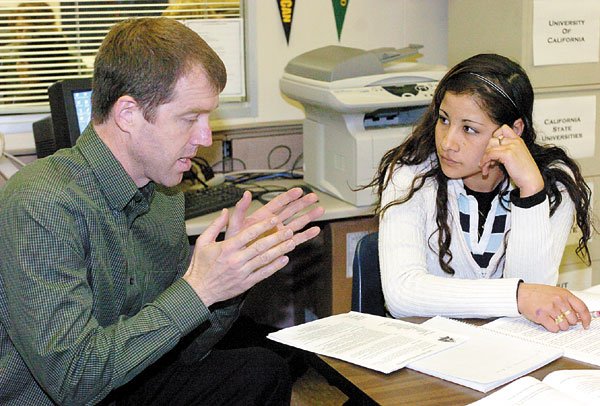Gilroy
– January’s cold snap caused severe crop damage, and the
resulting loss of job opportunities on area farms will keep many
migrant workers and their children away.
Gilroy – January’s cold snap caused severe crop damage, and the resulting loss of job opportunities on area farms will keep many migrant workers and their children away.
The temporary drop in migrant student population in spring 2007 is likely to cost the school district thousands of dollars next year, since federal funding is awarded on a per-student basis, though the district might face increased needs in 2008.
The possible disparity in funding could leave more than 1,500 of the most vulnerable students and their families with decreased educational opportunities and services.
These students, “on top of being at risk because of being an (English) language learner, have another risk factor due to gaps in education,” said Kermit Schrock, migrant education director at Gilroy High School. “And a second factor is they will tend to have socioeconomic disadvantages. In that regard, it’s just they are a little extra at risk.”
To reduce these factors, which can contribute to higher dropout rates, lower grades and greater incidents of disciplinary action, the district supports a number of scholastic and social programs.
The district tries to address the needs of both the highly mobile migrant students, who travel to other states according to the seasons for agricultural work, and the migrant students that stay in state or even in the city, but miss weeks at a time due to their families having inconsistent employment.
The programs that address these needs include coordinated efforts with out-of-state school districts so teachers can access migrant students’ transcripts and better judge their academic level, an independent study program that provides partial credit for unfinished classes and work done outside class time and a mobile clinic that serves those without medical insurance.
Rosario Juanez, an 18-year old GHS student, is one of the hundreds using the independent work program, known as Portable Assisted Study Sequence, to graduate. Moving from Oaxaca, Mexico just two year ago with no knowledge of English, Juanez has used the PASS program to augment her studies so that she can graduate in just three years.
Operating PASS and these outreach programs, however, costs hundreds of thousands of dollars each year. The Gilroy Unified School District’s budget for the 2006-2007 school year was $412,821.
For 2007-2008, because of a decrease in the number of area jobs for migrant workers this spring and because of the way the United States government funds the program, the district might see thousands of dollars less despite typical student enrollment.
The cold front that hit California in January decimated local and regional crops, decreasing jobs in the area. Because roughly a third of students in the migrant education program are children of migrant workers, who depend upon these seasonal jobs, many of these students will not come to the district this spring.
“If we don’t sustain the numbers we’ve had in the past, our funding is really going to suffer,” said Lorena Tariba, coordinator of migrant education.
As the district receives its 2007-2008 funding based on the number of migrant students in the area in 2006-2007, it is poised to lose money as a result of decreased student enrollment this year. However, by 2007-2008, the agricultural industry is likely to rebound, bringing back migrant workers and their children despite the decreased funding. District officials could not immediately estimate the number of students missing, nor what that would cost it next year.
Further complicating the matter, the U.S. government does not allow the district to carry money over from one fiscal year to the next. However, the federal government does allow carryover at a state level.
In the past “that’s helped us balance the deficits that some of us have seen,” Tariba said.
However, districts cannot count on that money because it relies on other districts voluntarily not spending their funds, she added.
Thus, the question is “how we will restructure the program to maintain the level and the quality of the services,” she said.
While Tariba has already started exploring new partnerships with local organizations to share costs, she is primarily waiting to see how bad the situation is before she acts.
“This is the time where we start to see (migrant families) coming or not coming,” Tariba said. “We’re already starting to hear from other areas, from other migrant programs that they’ve seen other people leaving their areas because of the lack of work due to the freeze.”
Yet the district might be facing another problem as the migrant workers leaving the Central Valley come to Gilroy, where there are stable, year-round jobs such as in construction, Tariba said.
This influx of students would push the budget shortfall up from the 2007-2008 school year to the current school year.
Tariba acknowledges that the district is puzzled.
“That is the big question mark for us,” she said. “How is the freeze in other areas going to affect us here.”















